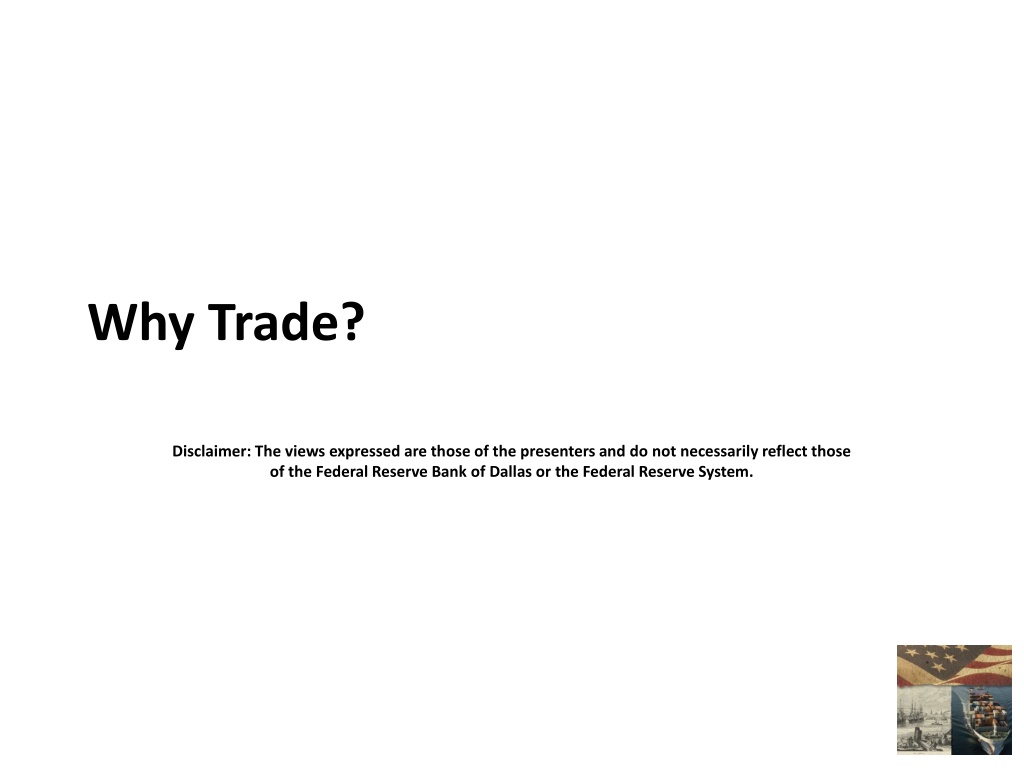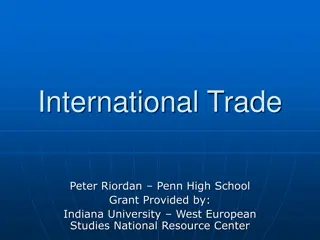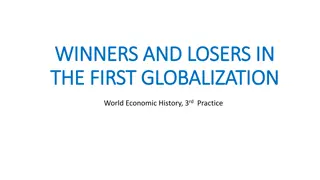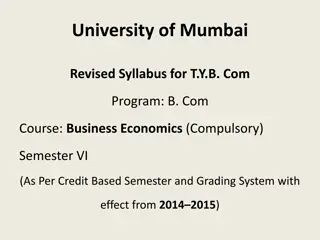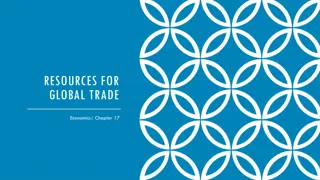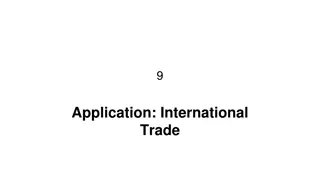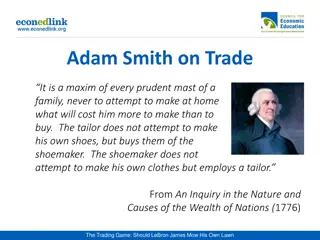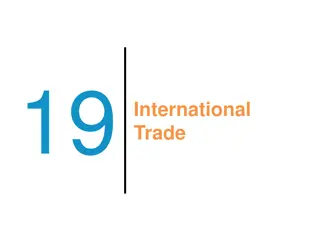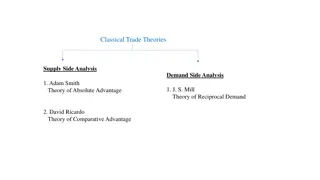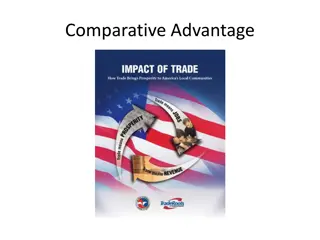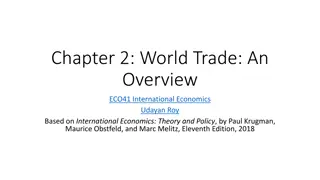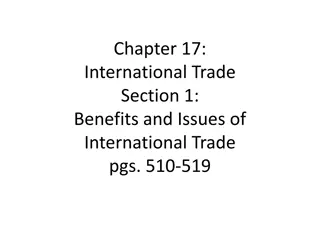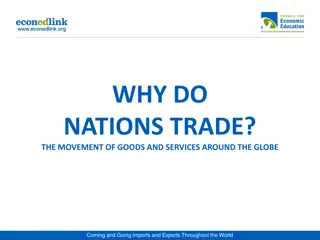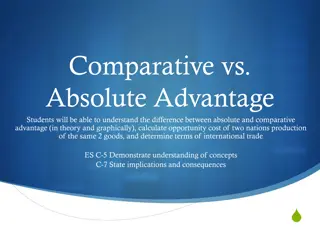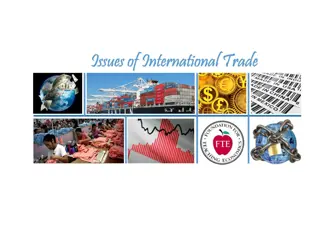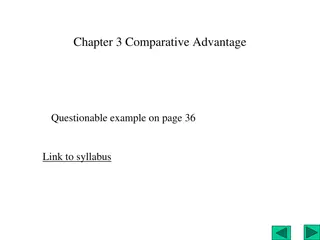Understanding the Concepts of Trade and Comparative Advantage
Explore the fundamental concepts of trade, specialization, absolute and comparative advantage, opportunity costs, and more. Learn how nations can benefit from trade, even without absolute advantage, and the importance of making choices based on opportunity costs. Discover how differing opportunity costs impact investments in technology, key inputs, natural resources, labor, and government services in trade scenarios.
Download Presentation

Please find below an Image/Link to download the presentation.
The content on the website is provided AS IS for your information and personal use only. It may not be sold, licensed, or shared on other websites without obtaining consent from the author. Download presentation by click this link. If you encounter any issues during the download, it is possible that the publisher has removed the file from their server.
E N D
Presentation Transcript
Why Trade? Disclaimer: The views expressed are those of the presenters and do not necessarily reflect those of the Federal Reserve Bank of Dallas or the Federal Reserve System.
Gains from Trade Distribute bags and rate satisfaction Divide into groups of three, trade and rate satisfaction after trade Trade with everyone in the room and rate satisfaction after trade
Two Concepts Trade Occurs when parties expect to gain Trade among individuals or organizations within a nation or in different nations Specialization Producers specialize in what they can produce at the lowest cost Necessitates trade Production and (total) consumption increase
Absolute Advantage The natural advantages which one country has over another in producing particular commodities are sometimes so great that it is acknowledged by all the world to be in vain to struggle with them. Adam Smith in Wealth of Nations Book IV, Chapter 2
Comparative Advantage David Ricardo showed that nations could benefit from trade even without an absolute advantage. Comparative advantagerefers to a country s ability to produce a good at a lower opportunity cost than another country.
Opportunity Costs An economic way of thinking Costs are not monetary The cost of getting something is really the value of the next best alternative that is not chosen Think about the choices you make Nap or workout on Sunday afternoon Beach or mountains or city for vacation
Differing Opportunity Costs Investments in technology Relative supply of key inputs Land (natural resources) Labor (both skilled and unskilled) Capital Government services and regulations
Imagine two islands Both produce fish and coconuts Fishing requires boats (capital) and labor Coconut harvest requires trees (land) and labor Different amounts of resources One island has many trees and few boats Other island has many boats, but few trees
Coconut Island Resources lots of coconut trees and only a few boats Coconut Industry thriving coconut harvests with lots of competition Fishing Industry very little fishing and almost no competition Food supply abundant coconuts and scarce fish Consumers cheap coconuts and expensive fish
Fish Island Resources lots of boat and only a few trees Coconut Industry small harvests and no competition Fishing Industry abundant catches and intense competition Food supply abundant fish and scarce coconuts Consumers cheap fish and expensive coconuts
New connections Prices equalize Innovation Trade
The Impact of Trade Who cares about the price of coconuts? People who eat coconuts People who own trees (land) People who climb trees (labor) Who cares about the price of fish? People who eat fish People who own boats (capital) People who sail and fish (labor)
Who Could Object? Domestic Price > World Price Country imports domestic price falls Domestic consumers benefit. Domestic producers are harmed.
Who Could Object? Domestic Price < World Price Country exports domestic price rises Domestic producers benefit. Domestic consumers are harmed.
Tariff Tax on imported goods or services Reasons for tariffs Raise tax revenues Reduce consumption of the imported good or service Effect Price of import rises, cheaper domestic goods become more attractive
Percent of Federal Budget from Tariffs 100.00% 90.00% 80.00% 70.00% 60.00% 50.00% 40.00% 30.00% 20.00% 10.00% 0.00% 179218001810182018301840185018601864187018801890191019151917192019281935194219461950195519651975198519952005
Percent of Federal Budget from Tariffs 100.00% 90.00% 80.00% 70.00% 60.00% 50.00% 40.00% 30.00% 20.00% 10.00% 0.00%
Types of Federal Revenue as a percentage of total receipts 100% 90% 80% 70% 60% 50% 40% 30% 20% 10% 0% Tariff Income Tax Payroll Tax Other
Alexander Hamilton Proposed extensive tariffs to provide revenue and protect American manufacturers (rooted in mercantilism) Three tariff acts 1789 1790 1792
Andrew Jackson Tariff Act of 1828 (Tariff of Abominations) Nullification Crisis
Progressive Ideal Replace tariffs with income tax 1913 watershed year Underwood Tariff Act lowered tariffs Federal income tax created
Ongoing Fordney McUmber Tariff (1922) Smoot Hawley (1933)
Quota Limits the amount of an imported good allowed into the country Supply is decreased and price increases Voluntary Export Restrictions (VER s) are similar
Export Subsidy Government financial assistance to a firm that allows a firm to sell its product at a reduced price Benefits and harms Consumers (both at home and abroad) benefit from lower prices Foreign producers are harmed because of lower world prices Taxpayers in the producing country pay the subsidy
Product Standards A type of hidden trade barrier Types of standards Product safety Content Packaging
